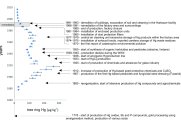Larch – an archive of mercury concentrations
A paper by scientists of the Department of Environmental Geology and Geochemistry was published in the prestigious journal Environmental Pollution. The study of tree rings in European Larch determined the evolution of mercury (Hg) emissions from a local source. Larch is a living recorder of Hg concentrations in the air. In this case, the emission source was the oldest chemical plant in the German town of Marktredwitz, which was producing Hg-based fungicides. Its environs were contaminated during the centennial operation of the plant. Mercury then started to spread to the Czech Republic through streams, inducing contamination of sediments in the Skalka Reservoir in the Cheb area. The record in larch rings suggests that the highest Hg emissions occurred in the first decades of the 20th century, when the plant was the World's key producer. The present Hg concentrations in the air are very low due to the extensive remediation of the whole plant area.


